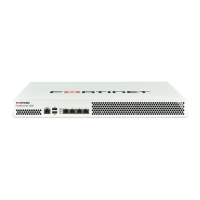Video management Page 85 FortiRecorder 2.4.2 Administration Guide
4. Click Apply.
5. Go to Camera > Configuration > Camera, then click to select a camera’s row, then click Edit.
6. For Profile, click New or Edit.
7. From Storage Options, select Move. In the After n options that appear, select the age
threshold that will cause FortiRecorder to move the video clips to external storage. Note that
the Move option only appears after you have configured and enabled external storage.
8. Click Create.
See also
• Camera settings
Directory Enter the path of the folder on the server, relative to the mount
point or user’s login directory, where the FortiRecorder
appliance will store the data.
This setting appears only if Protocol is NFS.
Note: Do not use special characters such as a tilde ( ~ ). This
will cause the storage to fail.
Encryption Key Enter the private key that will be used to encrypt data stored
on this location. Valid key lengths are between 6 and 64
single-byte characters.
This setting appears only if Protocol is ISCSI Server
iSCSI ID Enter the iSCSI identifier in the format expected by the iSCSI
server, such as an iSCSI Qualified Name (IQN), Extended
Unique Identifier (EUI), or T11 Network Address Authority
(NAA).
This setting appears only if Protocol is ISCSI Server.
Setting name Description
If the remote iSCSI device has not been formatted, before you can use it, you must format it
with the following CLI command: execute storage format

